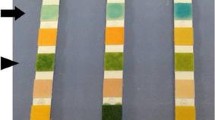Abstract
The aim of the study was to validate the reliability of samples obtained with urine collection pads (UCP) for selected laboratory biochemical analyses, urine cell microscopy, and bedside semi-quantitative stick urinalysis. A series of laboratory experiments was performed to test agreement between urine concentrations, or results, before and after passage through a UCP (incubated for 37°C for 15 min). The following urinalyses were performed: electrolytes, calcium, phosphate, urate, osmolality, pH, protein, catecholamines, toxicology for drugs of abuse, stick urinalysis for glucose, ketones, protein, blood, leucocytes and nitrites, and microscopy for red and white cells. Close agreement was shown for all laboratory analyses except proteinuria, which was underestimated by, on average, 10% after UCP passage. However, stick urinalysis for proteinuria remains sufficiently reliable for clinical use. UCP substantially retain or destroy red and white cells, but stick urinalysis for blood and leucocyte esterase remains reliable. In conclusion, urine samples derived from UCP show good agreement across a clinically relevant range for the biochemical analyses undertaken in this study. Microscopy of UCP samples is unreliable for cellular material but semi-quantitative stick urinalysis for red and white cells is a satisfactory alternative.














Similar content being viewed by others
References
Vernon S, Redfearn A, Pedler SJ, Lambert HJ, Coulthard MG (1994) Urine collection on sanitary towels. Lancet 334:612
Lewis J (1998) Clean catch versus urine collection pads: a prospective trial. Pediatr Nurs 10:15–16
Feasey S (1999) Are Newcastle urine collection pads suitable as a means of collecting specimens from infants? Pediatr Nurs 2:17–21
Macfarlane PI, Houghton C, Hughes C (1999) Pad urine collection for early childhood urinary tract infection. Lancet 354:571
Liaw LCT, Nayar D, Pedler SJ, Coulthard MG (2000) Home collection of urine for culture from infants by three methods: survey of parents’ preferences and bacterial contamination rates. BMJ 320:1312–1313
Rao S, Houghton C, Macfarlane PI (2003) A new urine collection method; pad and moisture sensitive alarm. Arch Dis Child 88:836
Rao S, Bhatt J, Houghton CH, Macfarlane PI (2004) An improved urine collection pad method; a randomised clinical trial. Arch Dis Child 89:773–775
Roberts SB, Lucas A (1985) Measurements of urinary constituents and output using disposable napkins. Arch Dis Child 60:1021–1024
Ahmad T, Vickers D, Campbell S, Coulthard MG, Pedler S (1991) Urine collection from disposable nappies. Lancet 338:674–676
Mock D (1992) Rayon balls and disposable-diaper material selectively absorb creatinine. Am J Clin Nutr 55:326–330
Smith GC, Taylor CM (1992) Recovery of protein from urine specimens collected in cotton wool. Arch Dis Child 67:1486–1487
Kirkpatrick JM, Alexander J, Cain RM (1997) Recovering urine from diapers: are test results accurate? Am J Matern Child Nurs 22:96–102
Kishel M, Lichty PNA (1979) Some diaper brands give false-positive test for PKU. N Engl J Med 300:200
Partsch CJ, Aukamp M, Sippel WG (2000) Scrotal temperature is increased in disposable plastic line nappies. Arch Dis Child 83:364–368
Fitzgibbon MC, Tormey WP (1994) Paediatric reference ranges for urinary catecholamines/metabolites and their relevance in neuroblastoma diagnosis. Ann Clin Biochem 31:1–11
Bland JM, Altman D (1986) Statistical methods for assessing agreement between two methods of clinical measurement. Lancet I:307–310
Hutton NM, Schreiner RL (1980) Urine collection in the neonate, effect of different methods on volume, specific gravity and glucose. J Obstet Gynecol Neonatal Nurs 9:165–169
Williams PR, Kanarek HS (1982) Urine evaporative loss and effects on specific gravity and osmolality. J Pediatr 100:626–628
Muratore C, Dhanireddy R (1993) Urine collection from disposable diapers in premature infants: biochemical analysis. ClinPediatr (Phila) 32:314–315
Schoenle EG, Lang-Muritano M, Gschwend S, Laimbacher J, Mullis PE, Torresani T, Biason-Lauber A, Molinari L (2001) Epidemiology of type I diabetes mellitus in Switzerland: steep rise in incidence in under 5 year old children in the past decade. Diabetologia 44:286–289
Ghazali S, Barratt TM (1974) Urinary excretion of calcium and magnesium in children. Arch Dis Child 49:97–101
Singh J, Moghal N, Pearce SHS, Cheetham T (2003) The investigation of hypocalcaemia and rickets. Arch Dis Child 88:403–407
Simmons WK (1972) Urinary urea nitrogen/creatinine ratio as an indicator of recent protein intake in field studies. Am J Clin Nutr 25:539–542
Adewusi SR, Tomiro SE, Akindahunsi AA (2002) Prediction of nutritional status by chemical analysis of urine and anthropometric methods. Nutr Health 16:195–202
Matos V, Van Melle G, Werner D, Bardy D, Guignard JP (1999) Urinary oxalate and urate to creatinine ratios in a healthy paediatric population. Am J Kidney Dis 34:e1
Abithol C, Zilleruelo G, Freundlich M, Strauss J (1990) Quantitation of proteinuria with urinary protein/creatinine ratios and random testing with dipsticks in nephrotic children. J Pediatr 116:243–247
Matos V, Van Melle G, Boulat O, Markert M, Bachman C, Guignard JP (1997) Urinary phosphate/creatinine, calcium/creatinine and magnesium creatinine ratios in a healthy paediatric population. J Pediatr 131:252–257
Acknowledgements
We are grateful to Dr. Ian Marsh from the Toxicology Laboratory, Royal Hallamshire Hospital, Sheffield, UK whose laboratory provided anonymous adult urine samples containing drugs of abuse for toxicological analysis and to Mrs. Amanda Wilson, who typed the manuscript.
Author information
Authors and Affiliations
Corresponding author
Rights and permissions
About this article
Cite this article
Macfarlane, P.I., Ellis, R., Hughes, C. et al. Urine collection pads: are samples reliable for urine biochemistry and microscopy?. Pediatr Nephrol 20, 170–179 (2005). https://doi.org/10.1007/s00467-004-1709-4
Received:
Revised:
Accepted:
Published:
Issue Date:
DOI: https://doi.org/10.1007/s00467-004-1709-4




